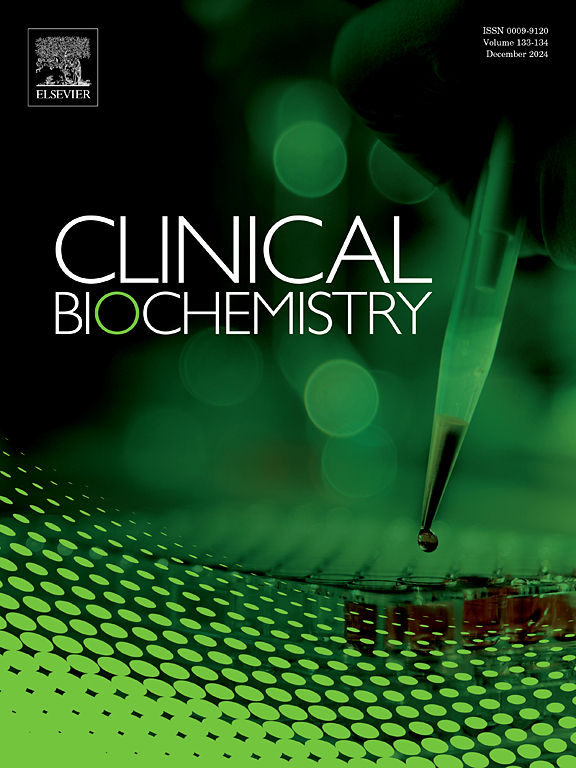Determining susceptibility of routine clinical biochemistry assays to methylene blue interference
IF 2.1
3区 医学
Q2 MEDICAL LABORATORY TECHNOLOGY
引用次数: 0
Abstract
Introduction
Methylene blue (MB) is a blue-coloured treatment for multiple indications, including methemoglobinemia. Its interference potential with spectrophotometric and/or colorimetric clinical assays has not been well studied.
Objective and methods
We determined an MB absorbance spectrum and identified spectrophotometric assays in our core laboratory with interference potential based on their wavelengths. We identified twelve Roche cobas c502/c702 chemistry assays and co-oximetry on the Werfen GEM Premier 4000 blood gas analyzers as potentially susceptible. We also tested colorimetric urinalysis performed on a Roche cobas u601 urine analyzer. For Roche cobas c502/c702 assays or urinalysis, we performed an initial study with MB mostly at concentrations of 10 or 100 mg/L (or water as a control) in leftover patient specimens with relevant analyte concentrations. For co-oximetry, venous whole blood from healthy donors was spiked with MB. For assays with differences between MB-spiked samples and controls exceeding total allowable error, dose–response studies were performed to better characterize the MB concentrations causing interference.
Results
MB >0.1, >0.01, and >0.08 mg/L, respectively, caused negative interference with the cobas c502 hemolysis index, positive interference with the cobas c502 lipemia index, and positive interference with the cobas c702 urine amphetamines assay. MB at ≥50–70 mg/L in venous whole blood yielded incalculable co-oximetry results on the GEM Premier 4000. These interferences were not felt to be clinically concerning. However, a urine MB concentration of ≥5 mg/L interfered with most urinalysis parameters on the cobas u601 analyzer. Automated comments based on colour detection were introduced to make clinicians aware of potential MB interference with urinalysis.
Conclusion
We identified the assays in our core laboratory susceptible to MB interference and addressed them where clinically indicated.
常规临床生化检测对亚甲基蓝干扰的敏感性测定
亚甲基蓝(MB)是一种用于多种适应症的蓝色治疗药物,包括高铁血红蛋白血症。其与分光光度法和/或比色法临床试验的干扰潜力尚未得到很好的研究。目的和方法确定了MB吸光度光谱,并在我们的核心实验室中确定了基于波长的干扰电位分光光度测定法。我们在Werfen GEM Premier 4000血气分析仪上鉴定了12项罗氏cobas c502/c702化学测定和共氧测定具有潜在敏感性。我们还测试了Roche cobas u601尿液分析仪进行的比色尿液分析。对于Roche cobas c502/c702检测或尿液分析,我们在剩余的具有相关分析物浓度的患者标本中使用浓度为10或100 mg/L(或水作为对照)的MB进行了初步研究。在共氧测定中,健康献血者的静脉全血中加入了MB。对于添加MB的样本和对照组之间的差异超过总允许误差的分析,进行剂量反应研究,以更好地表征引起干扰的MB浓度。结果smb >;0.1、>;0.01和>;0.08 mg/L分别对cobas c502溶血指数产生负干扰,对cobas c502血脂指数产生正干扰,对cobas c702尿安非他明测定产生正干扰。静脉全血中≥50-70 mg/L的MB在GEM Premier 4000上产生不可计算的共氧测定结果。这些干扰在临床上并不值得关注。然而,尿MB浓度≥5 mg/L会干扰cobas u601分析仪的大多数尿液分析参数。引入基于颜色检测的自动评论,使临床医生意识到潜在的MB干扰尿液分析。结论:我们确定了核心实验室易受MB干扰的检测方法,并在临床需要时对其进行了处理。
本文章由计算机程序翻译,如有差异,请以英文原文为准。
求助全文
约1分钟内获得全文
求助全文
来源期刊

Clinical biochemistry
医学-医学实验技术
CiteScore
5.10
自引率
0.00%
发文量
151
审稿时长
25 days
期刊介绍:
Clinical Biochemistry publishes articles relating to clinical chemistry, molecular biology and genetics, therapeutic drug monitoring and toxicology, laboratory immunology and laboratory medicine in general, with the focus on analytical and clinical investigation of laboratory tests in humans used for diagnosis, prognosis, treatment and therapy, and monitoring of disease.
 求助内容:
求助内容: 应助结果提醒方式:
应助结果提醒方式:


